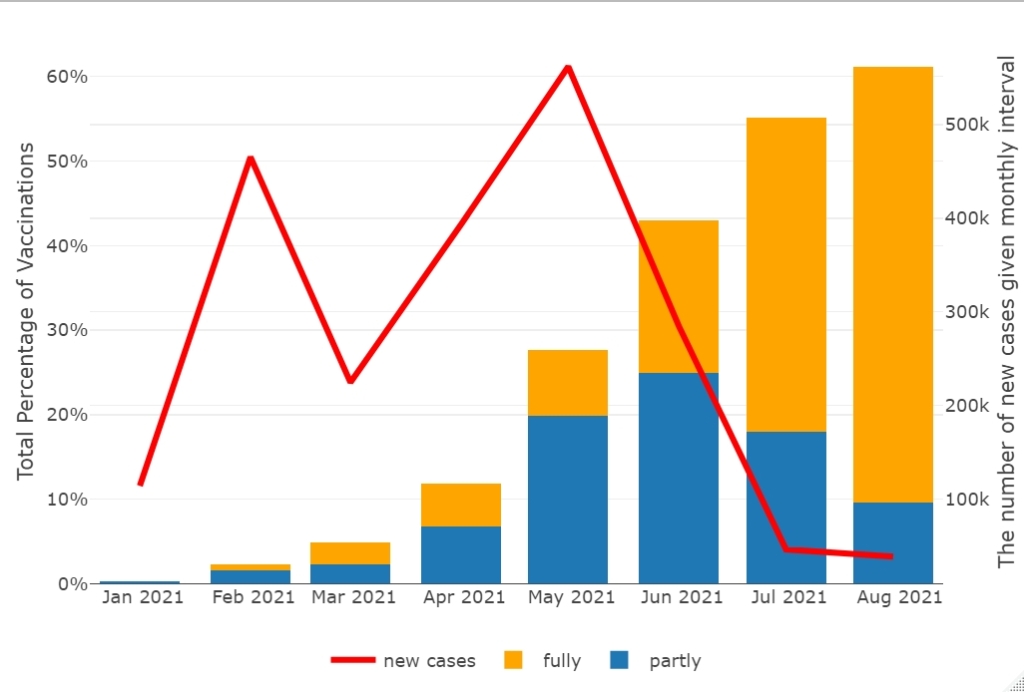One of the most frequently asked questions these days is whether the vaccine works in reducing the number of cases and deaths. In order to examine that we will build a function so that we can run for every country we want without repeating the same code block.
The dataset we’re going to use for this article is from Our World in Data. What we want to do here is that we will determine the partial and total vaccination rates as a percentage relative to the relevant population. And we will examine the relationship between the number of cases and deaths given in certain monthly periods and the vaccination rates.
library(readxl)
library(dplyr)
library(lubridate)
library(rlang)
library(scales)
library(tidyr)
library(stringr)
library(purrr)
library(plotly)
df_raw <- read_excel("covid19_vacc.xlsx")
cement <- function(...){
args <- ensyms(...)
paste(purrr::map(args,as_string))
}
The function we’ve built called cement is taken from Advanced R book. The purpose of the function is that saves us from writing our arguments in string form, which sometimes can be quite annoying; with this function, we can write our arguments without in quotes.
fun <- function(...){
#Assigning the symbols as strings
var_loc <- cement(...)[1]
var_toll <- cement(...)[2]
df <- df_raw %>%
.[.$location==var_loc,] %>%
transmute(
date=date %>% as.Date(),
#First phase vaccinated people
partly=people_vaccinated-people_fully_vaccinated,
#Fully vaccinated people
fully=people_fully_vaccinated,
total_vaccinations,
new_cases,
new_deaths,
population
) %>% na.omit() %>%
group_by(month = format(date, "%Y%m")) %>%
mutate(
#The monthly amount
new_cases=cumsum(new_cases),
new_deaths=cumsum(new_deaths),
) %>%
#The last observation for each month
slice(which.max(cumsum(partly & fully))) %>%
ungroup() %>%
select(-month) %>%
#For percentage demonstration
mutate(partly_rate=round(partly/population,4)*100,
fully_rate=round(fully/population,4)*100)
fig <- plot_ly(df)
fig %>%
add_trace(x = ~date, y = ~partly_rate, type = 'bar',
name = 'partly',
marker = list(color = 'ligthblue'),
hoverinfo = "text",
text = ~paste(partly_rate, '%')) %>%
add_trace(x = ~date, y = ~fully_rate, type = 'bar',
name = 'fully',
marker = list(color = 'orange'),
hoverinfo = "text",
text = ~paste(fully_rate, '%')) %>%
add_trace(x=~date, y=~.data[[var_toll]], type='scatter',mode='lines',
name=str_replace(var_toll,"_"," "),
yaxis="y2",
line = list(color = 'red',width=4),
hoverinfo="text",
#.data is the pronoun provided by data masks:https://adv-r.hadley.nz/evaluation.html#pronouns
text=~paste(comma(.data[[var_toll]]))) %>%
layout(barmode = "stack",
legend=list(orientation='h', #horizontal
xanchor="center", #center of x axis
x=0.5),
xaxis=list(title=""),
yaxis=list(side='left',
ticksuffix="%",
title='Total Percentage of Vaccinations'),
yaxis2=list(overlaying="y",
side='right',
automargin=TRUE, #prevents axis title from overlapping the labels
title=paste("The number of",
str_replace(var_toll,"_"," "),
"given monthly interval")))
}
fun(Turkey,new_cases)

fun(Germany,new_cases)

When we examine the graphs, we see that the total vaccinations are below 50% in Turkey and above 60% in Germany. Both countries peaked in the number of cases in May, but there has been a steady decline in the cases line since then as the proportion of people fully vaccinated has risen. We can clearly see that the vaccine has worked so far. So get vaccinated as soon as possible, please!

Nice, but it seems to me that the month does not match
LikeLike
Great function! However, did you check ‘Netherlands’?
LikeLike
Sorry, but I don’t agree with your conclusion. As a statistician you should know that correlation, consequence and coincidence are not the same thing. I can create a graph that shows the increase in CO2 emissions along with the increase in Obama’s age but that is not proof that Obama’s age has an impact on CO2 emissions. An interesting piece of work would be to compare the evolution of the epidemic in many countries using multivariate models to determine which variables can explain the disappearance or increase of the virus.
LikeLike
Thanks for posting details of the function and the data source. The examples you illustrate do indeed indicate a correlation between vaccination and new cases, however, how would you explain the data from Ireland, the United Kingdom, Australia, New Zealand etc., which do not conform with this trend? Have you also considered that COVID-19 is a seasonal virus and that this may explain the trend you highlight?
LikeLike